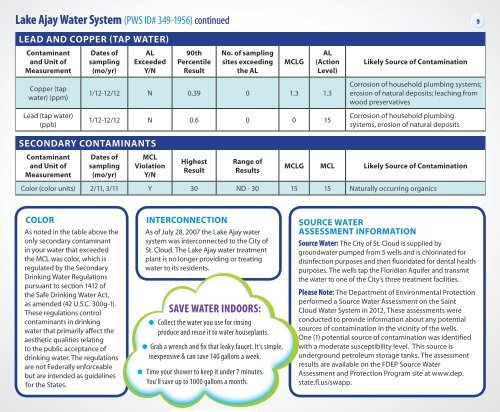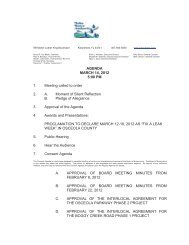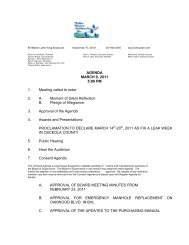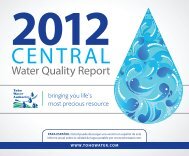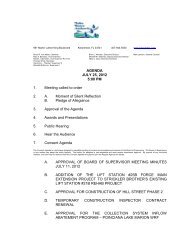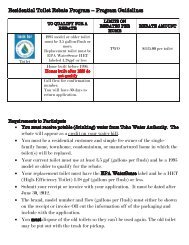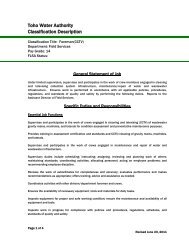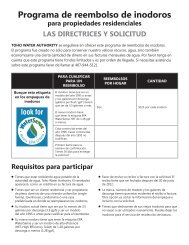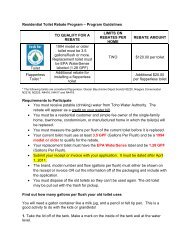Eastern Report - Toho Water Authority
Eastern Report - Toho Water Authority
Eastern Report - Toho Water Authority
Create successful ePaper yourself
Turn your PDF publications into a flip-book with our unique Google optimized e-Paper software.
Lake Ajay <strong>Water</strong> System (PWS ID# 349-1956) continued 9<br />
Lead and Copper (Tap <strong>Water</strong>)<br />
Contaminant<br />
and Unit of<br />
Measurement<br />
Dates of<br />
sampling<br />
(mo/yr)<br />
AL<br />
Exceeded<br />
Y/N<br />
90th<br />
Percentile<br />
Result<br />
No. of sampling<br />
sites exceeding<br />
the AL<br />
MCLG<br />
AL<br />
(Action<br />
Level)<br />
Likely Source of Contamination<br />
Copper (tap<br />
water) (ppm)<br />
Lead (tap water)<br />
(ppb)<br />
1/12-12/12 N 0.39 0 1.3 1.3<br />
1/12-12/12 N 0.6 0 0 15<br />
Corrosion of household plumbing systems;<br />
erosion of natural deposits; leaching from<br />
wood preservatives<br />
Corrosion of household plumbing<br />
systems, erosion of natural deposits<br />
Secondary Contaminants<br />
Contaminant<br />
and Unit of<br />
Measurement<br />
Dates of<br />
sampling<br />
(mo/yr)<br />
MCL<br />
Violation<br />
Y/N<br />
Highest<br />
Result<br />
Range of<br />
Results<br />
MCLG MCL Likely Source of Contamination<br />
Color (color units) 2/11, 3/11 Y 30 ND - 30 15 15 Naturally occurring organics<br />
Color<br />
As noted in the table above the<br />
only secondary contaminant<br />
in your water that exceeded<br />
the MCL was color, which is<br />
regulated by the Secondary<br />
Drinking <strong>Water</strong> Regulations<br />
pursuant to section 1412 of<br />
the Safe Drinking <strong>Water</strong> Act,<br />
as amended (42 U.S.C. 300g-1).<br />
These regulations control<br />
contaminants in drinking<br />
water that primarily affect the<br />
aesthetic qualities relating<br />
to the public acceptance of<br />
drinking water. The regulations<br />
are not Federally enforceable<br />
but are intended as guidelines<br />
for the States.<br />
Interconnection<br />
As of July 28, 2007 the Lake Ajay water<br />
system was interconnected to the City of<br />
St. Cloud. The Lake Ajay water treatment<br />
plant is no longer providing or treating<br />
water to its residents.<br />
save water indoors:<br />
Collect the water you use for rinsing<br />
produce and reuse it to water houseplants.<br />
Grab a wrench and fix that leaky faucet. It’s simple,<br />
inexpensive & can save 140 gallons a week.<br />
Time your shower to keep it under 7 minutes.<br />
You’ll save up to 1000 gallons a month.<br />
Source <strong>Water</strong><br />
Assessment Information<br />
Source <strong>Water</strong>: The City of St. Cloud is supplied by<br />
groundwater pumped from 5 wells and is chlorinated for<br />
disinfection purposes and then fluoridated for dental health<br />
purposes. The wells tap the Floridian Aquifer and transmit<br />
the water to one of the City’s three treatment facilities.<br />
Please Note: The Department of Environmental Protection<br />
performed a Source <strong>Water</strong> Assessment on the Saint<br />
Cloud <strong>Water</strong> System in 2012. These assessments were<br />
conducted to provide information about any potential<br />
sources of contamination in the vicinity of the wells.<br />
One (1) potential source of contamination was identified<br />
with a moderate susceptibility level. This source is<br />
underground petroleum storage tanks. The assessment<br />
results are available on the FDEP Source <strong>Water</strong><br />
Assessment and Protection Program site at www.dep.<br />
state.fl.us/swapp.


